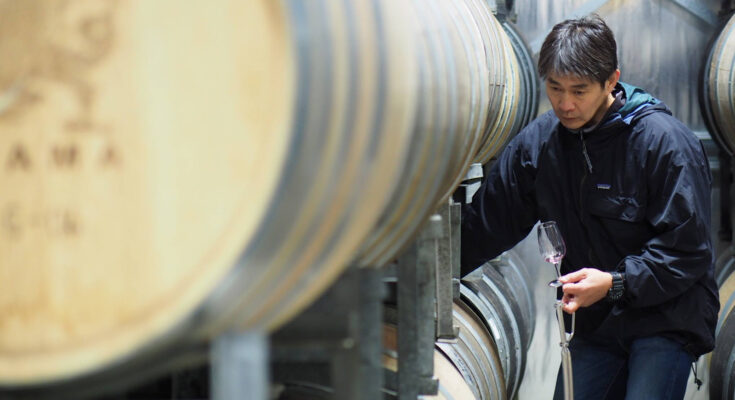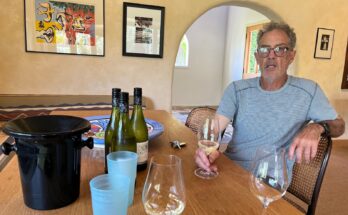I’m in the beautiful Waipara Valley – here to have a chat with a winemaker who has made some of the most characterful and personality-filled wines (the Pinot Noir in particular) that I’ve tried in recent times – Takahiro Koyama of Mountford Estate and Koyama. We start with a short stroll into the vineyard – short as it’s a blustery autumn evening in North Canterbury and, as usual, I’m not entirely dressed warmly enough for it.
WineFolio: It’s so beautiful here.
Takahiro Koyama: It is, we are here hiding from State Highway and we just do the tasting by appointment only. Not that many visitors, but after lockdown more kiwis are coming, and usually we have more international visitors.
The reason why they chose this site is of course the gentle slope and then steeper – those blocks are named The Gradient, which was planted in 2000 and a single block ‘The Rise’ planted in 2004, behind the winery. We are slowly expanding the vineyard. On the right is a mixture of four different varieties from Alsace, so Pinot Gris, Riesling, Muscat and Gewuztraminer. We pick those together, ferment together and make one wine. The first vintage was 2009 for those wines.
The Rise is 26 years old but it is struggling. There’s not much nutrient and not much water up there. It produces some really really good grapes but the vines are very small. With the quality we are happy, but the quantity… If we irrigate we could get more, but we haven’t irrigated for 5-6 years now. Dry farming is good, but you never know – maybe a drought is coming – like 2019 and 2020 was so dry. This year wasn’t too bad but they are still struggling. The irrigation is there now and we just have to restore the pump.
Frost fighting is a mission as well. Here it’s better than the bottom of the slope. This year we used a helicopter and it worked, but not perfect. We lost 50% but some people were worse off. We are going to buy a machine – a new tow and blow – that’s our best solution.
In front is our Chardonnay – mainly Mendoza. We stopped using herbicide, and are doing organic, although we are not certified. We’ll look at the paperwork in the future. I think it’s good for the market as well.
We decant to the gorgeous property that sits below the hill and with the lower vineyards spread out in front. I’m keen to try some of the wines and see what Takahiro has been working on.
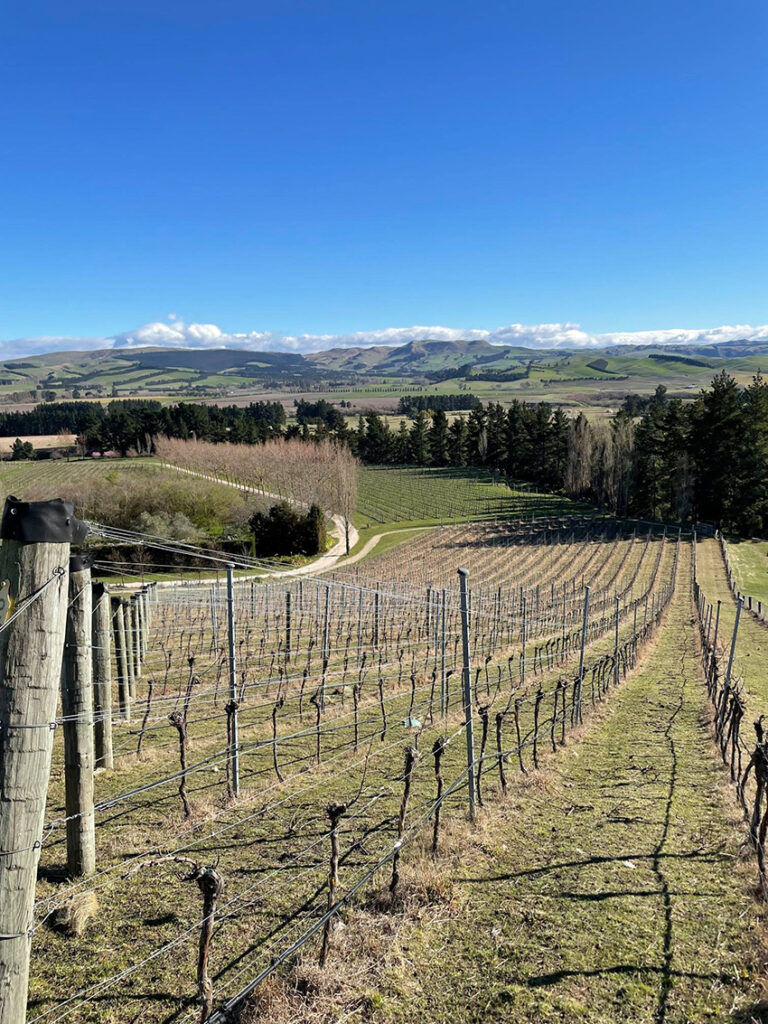
WF: I have a couple of bottles of 2011 Mountford Chardonnay and I like to surprise people with it, because I find not many people have had a Chardonnay from Waipara, and certainly not many people have tried Mountford, at all. It’s a really good wine, and the reaction is always “whoa, that’s amazing”.
Before we get started on the wines – who built this incredible house by the way?
TK: This was Mike and Buffy. This was an old train storage building, and they bought it, pick it up on a truck and brought it here, turned it into a house. I think it was built here in ’92 or ’93. It looks older. Michael was a painter and he used to teach art at school, and Buffy is an interior designer. Before they came here it was just bare land, grazing sheep.
Right, this is the 2015 Chardonnay – actually from before we purchased the property.
WF: I’m a Chardonnay fan, and some people will say that New Zealand has an identifiable style of it. I think that there is some truth to that, but I also believe that there’s a difference as you come down through Gisborne, then Hawke’s Bay, Wairarapa and into the South island. And when you get to North Canterbury, I find them more alike to Martinborough ones than anything else in the South Island – other than perhaps the Waikari ones which have their own thing.
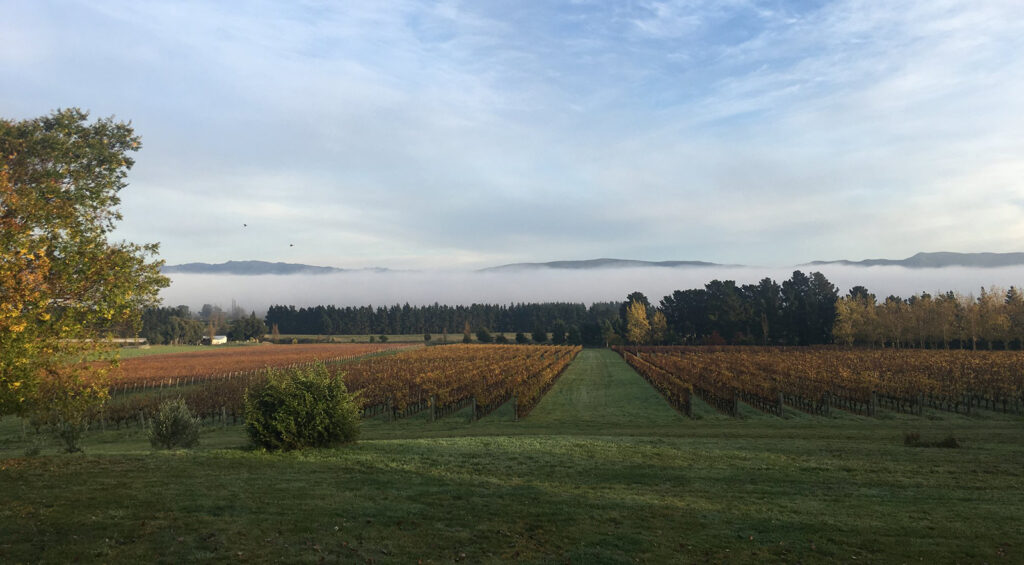
TK: I think Martinborough is a North-South valley. So when they get frosted, we get frosted. It’s a slightly similar climate sometimes. The soil is so different, but climate. Same with the Pinot when we do the blind tasting. It’s easy to tell the difference between Marlborough and here and Central, but sometimes we confuse Martinborough and Waipara.
For everything, we hand harvest and do the sorting in the winery. Chardonnay was whole bunch pressed, then, now, we don’t even settle – just straight into barrel. And barrel ferment with solids. After the fermentation is finished we start stirring the lees – once every two weeks. And then Malo is natural. Chardonnay we just keep in the barrel for about eighteen months or so. For whites we like to filter, but we don’t have to.
Lots of people confuse the Koyama and the Mountford label – it’s under the same company now. I came to New Zealand in 2003 and went to Lincoln to study winemaking. I started working here as a Cellar hand and in the Cellar Door, and then after I graduated, became the assistant winemaker to CP Lin. And then in 2009 I established my private label whilst I was still working here. In 2007 Michael and Buffy retired as they turned 70, so the second owners Kees and Kathryn took the place over. I left this property in 2012 and was making wine at The Crater Rim with Theo Coles, and the Koyama wine for myself. And then, in 2013, CP Lin left here and they were looking for a winemaker.
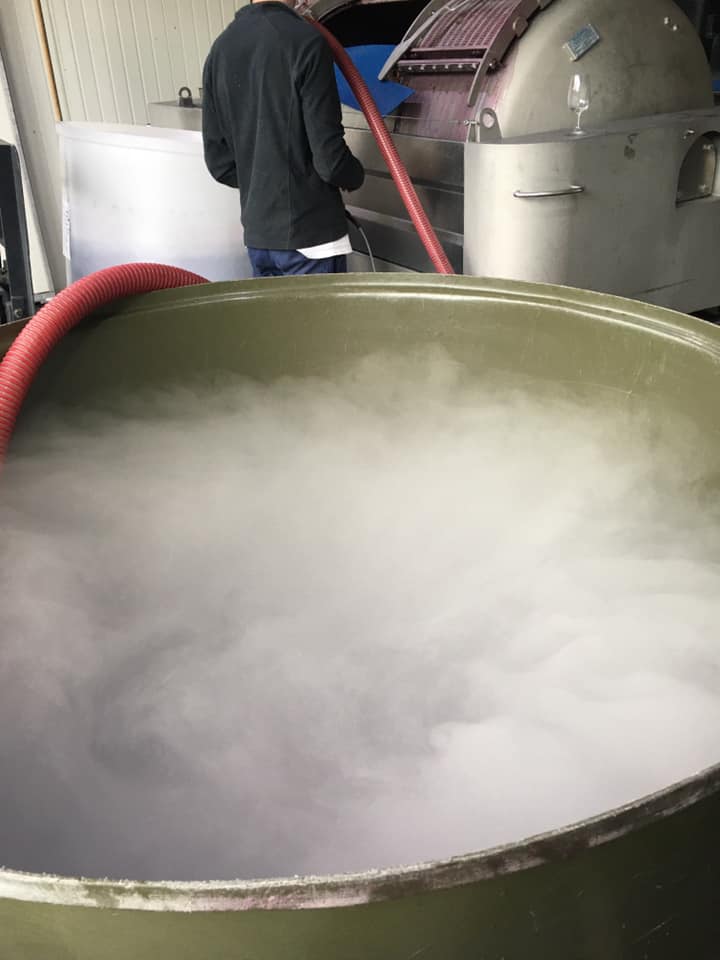
Theo Coles’ family used to own 100% share of The Crater Rim, having established the brand. But in 2009 there’s a fire and the whole winery is burnt out. They lost all the wines and all the equipment of course, so although they claimed for the insurance they couldn’t get 100% of the value back. So there was a guy who invested more money in the company and Theo became an employee winemaker, and he didn’t like it of course! And he left, and he came here. And I stayed at The Crater Rim. And then in 2017 Kees and Kathryn wanted to sell this property having been here for ten years but the business not doing well.
I got investment from Japan, so my company decided to purchase this property.
The first couple of years we made wine together with Theo until he found another place and moved out. So now, from 2017, Koyama Wines owns the Mountford Estate. We decided to keep both brands because there’s a different market.
WF: OK – I wasn’t sure quite how that puzzle fitted together. I’ve heard some of the names that you mention. Has it been hard putting your mark on it?
TK: Yes. Not just my name or anything, but Mountford Estate had disappeared from the market for a while. And when we took this place over, none of the wines had an export certificate, which means that they didn’t export anything at all. We are still quite strong in the UK, China and Japan also, so when we contacted those distributors they started taking it again. So now we are exporting to seven different countries. Before COVID we exported quite a lot – 60-70% and then 30-40% domestic, but right now it’s the other way round.
WF: Back to the wine – this is quite different from the wines I drank recently – those 2011 Chardonnays.
TK: Yes, it’s a different winemaker. CP is quite classic in his winemaking; Theo is in a more natural kind of way.
WF: It has quite a bit of character, whereas I think those 2011s were classic – juicy, fruity, with a nice dry finish. Everything I’m looking for in a good New Zealand Chardonnay. This has that smell of a winery, a barrel hall – it’s a ‘place’ wine. I’ve been exploring the world of natural wines and I find that ones that have a good amount of skin contact are very appealing to me – this has a little of that.
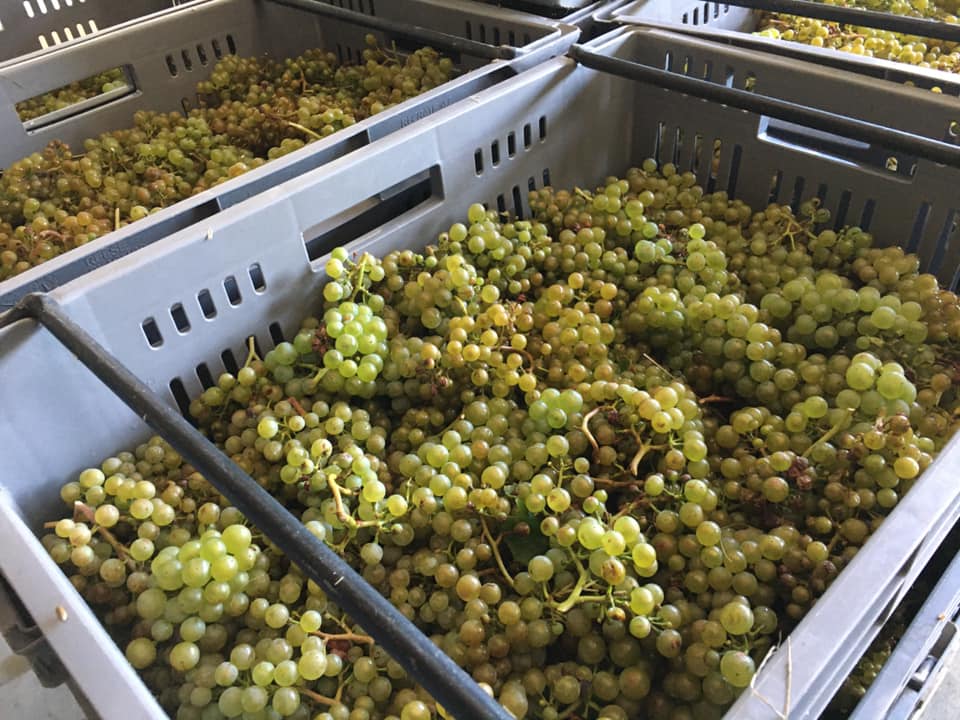
TK: The Chardonnay is selling really well, and we have a second tier wine from young vines called Liasion Chardonnay so now we are onto selling that as we run out of the Estate wine. Before they expanded this vineyard in 2009, we used to buy the grapes from other growers, but once this block started producing grapes we stopped buying. Now under the Mountford label it is 100% from here.
This Pinot Noir is from 2017 and from the Williams Vineyard next door. It has the same soil type but faces more directly north, so slightly warmer than here. A little bit of a wet vintage in 2017, although 2018 was really, really wet. I like the 2018 wine because it’s a pinot-ish Pinot. Not really dark and fruity – a bit different from normal.
WF: For me the colour of a Pinot isn’t what really informs me, it’s the smell of it.
TK: I agree. If you do the blind tasting and you smell it, you already know. If you don’t know, then you don’t… but the smell would tell you a lot.
We pick by hand and for this one, we used a bit of whole bunch. Up on the hill, the stems get ripe. Normally we use about 30%. I don’t like carbonic macerations so when we use whole bunch someone has to jump in and crush all the grapes. And then de-stemmed on top. Do the pump over at this stage until the fermentation starts. Once fermentation starts we do the plunging twice a day. Post ferment is not too long – about a week, ten days maybe. Then press it off, settle overnight and into barrel. Natural malo and, for this one, in barrel for eighteen months. Rack it off, settle again in tank and then straight into bottle.

I don’t want to call it a natural wine, but naturally made! The grapes from this block on the Gradient are always really nice. The Gradient is more north facing so a little bit bigger wine usually.
WF: It has a smoky earthiness to it, and a beautiful acidity.
TK: Climate wise, even if it gets over thirty degrees in the day in January – the night time temperature is around ten to fifteen degrees. The season is getting a little bit shorter over these last three years.
WF: I see you have ‘North Canterbury’ on your labels – how do you see that new style of regional definition going forward, because you would have been ‘Waipara’ for a long time?
TK: We have to – New Zealand Winegrowers told us to change the name. We can still put the Waipara name on there. When we are talking about the wine we always say Waipara.
WF: Well it’s both isn’t it. It is as well. You are Waipara, North Canterbury.
TK: This one has about 50% whole bunch.
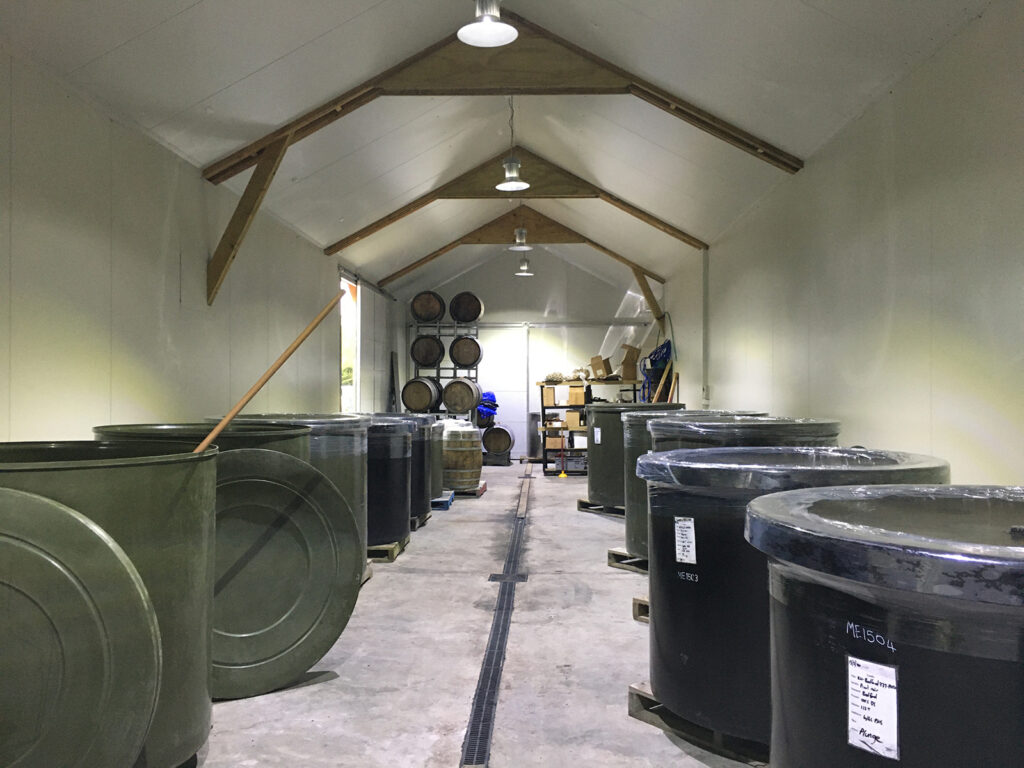
WF: Richer, broader, and the tannin has bit more grip. Nice balance between the acidity and the tannin. Sometimes I find Pinot is one or the other – built on acidity or built on tannin, and it’s rare to find something where you could say it was either, or both.
Have you had good reviews and scores for the wines?
TK: Yes, Bob likes our wine. This one was chosen for ‘Wine of the Week’. It helps (laughs). It’s nearly sold out now.
WF: This wine (the Williams Vineyard Pinot Noir) is 100% destemmed? There’s a real purity to this one and a power that comes from that. Lovely driving acidity.
TK: Yes, it’s a really nice vineyard – we buy the grapes for this one. Try to make a lower alcohol, like 14%. One thing that changed from 2000 to 2010 is that winemakers were interested in ripeness – always riper, riper. So when they pick the brix are high. And then most of the wine is over 14.5% alcohol. In 2009 people say it’s a fantastic, perfect vintage, but you end up with 15% alcohol. I start thinking – this is not right.
WF: So looking forward, what’s the future for you?
TK: To be honest, when we took over this place, the condition of some of the vineyard was so bad and it took 2-3 years to come back to normal. Of course then to stop using herbicide, put in a proper spraying programme and everything. But we’re not quite there yet, I think. Vine health is coming back but it might take another two or three years. And then we’ve got to start producing good quality, good volume wine from here. But at the same time we have to think about our climate changing as well. And that’s why we planted the nebbiolo on the hill. It might work, it might not, we’ll see.
We have a spring on the hill, and it is naturally flowing so we don’t have to use a pump. That’s the water that we use, and the other thing to consider is our carbon footprint as well. We use a lot of corks, and carbon footprint-wise that’s much better than a screwcap. Now they are even producing a cork called Lanaditech that is 100% TCA-free, which we might bring in… but it’s expensive! Right now we can only use corks for expensive wines. But in the future we might bring everything back to cork – against the trend. I believe cork is more ecological. We’re also looking at smaller things – we put solar panels on our warehouse, so we can save energy.
Last year we had really bad frosts. Winter was warm and then suddenly Spring came and it was minus three degrees for nine hours. Of course everybody did everything to protect the vines but sometimes it’s not enough. And the same thing happened in France this year. That kind of thing is happening, so we have to prepare for that. We’ll do whatever we can.
WF: What else do you think is going to be a big thing for New Zealand?
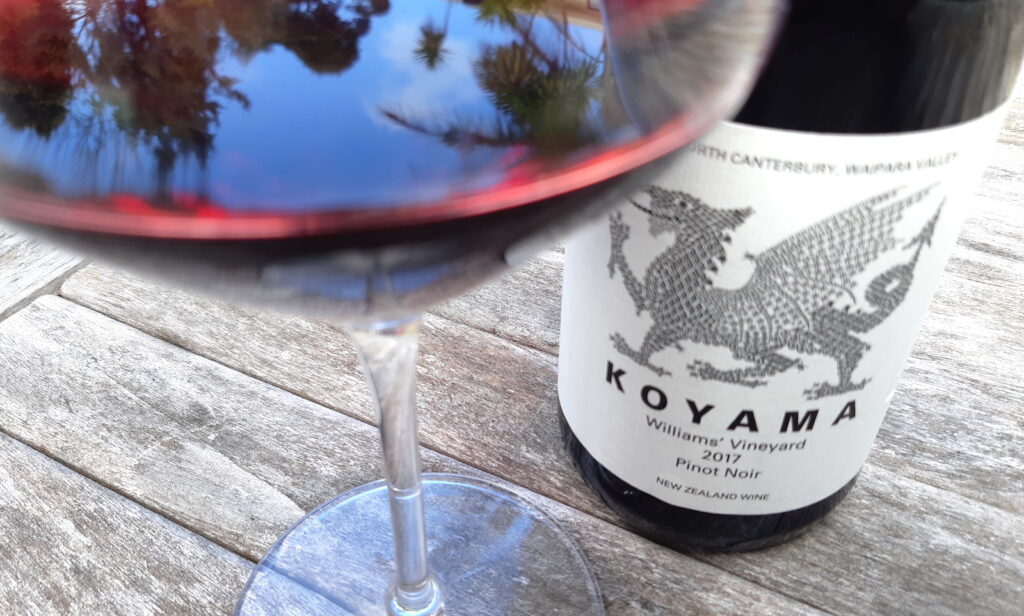
TK: I think there will be a wine shortage, with France and New Zealand 50% down. Maybe the model for the wine industry will change. Buyers are usually stronger than producers, but I think that’s going to change. It’s difficult for New Zealand because compared to somewhere like California, the weather is not stable. Especially in Waipara, Central and Martinborough where apart from 2020 there have been a run of small crops – ’17, ’18 and ’19, and now. Even in Bordeaux – they added some new varieties that they are now allowed to grow.
WF: And who would have thought they would make good wine in England? You mentioned that to me when I lived there… I would have laughed about it! And now it’s $100 a bottle.
Do you think that young people will continue to drink the types of wines that our fathers made, and that our generation still drink now?
TK: I think it depends on the country. In Japan people stopped drinking alcohol, including wine, but also stopped driving cars and motorbikes; stopped travelling overseas. For wine drinking I think that education is quite important.
I think that for New Zealand, fine wine is the best way to survive in a global market. Price and volume we cannot compete with Australia, Chile and Argentina. The weakness of Waipara is that our wine marketing is not good compared to Marlborough Winegrowers and Central Winegrowers. Of course in Marlborough there are some big companies. The Japanese market was big for us – ten years ago it was the best market – but now it isn’t growing. Now China is number 1, Hong Kong number 2, Singapore number 3, and Japan is number 4. When we talk to the non-wine drinking people they always say that “wine is difficult and I don’t understand it”. But I don’t think you have to understand it, to drink wine. If you like wine, just drink the wine.

